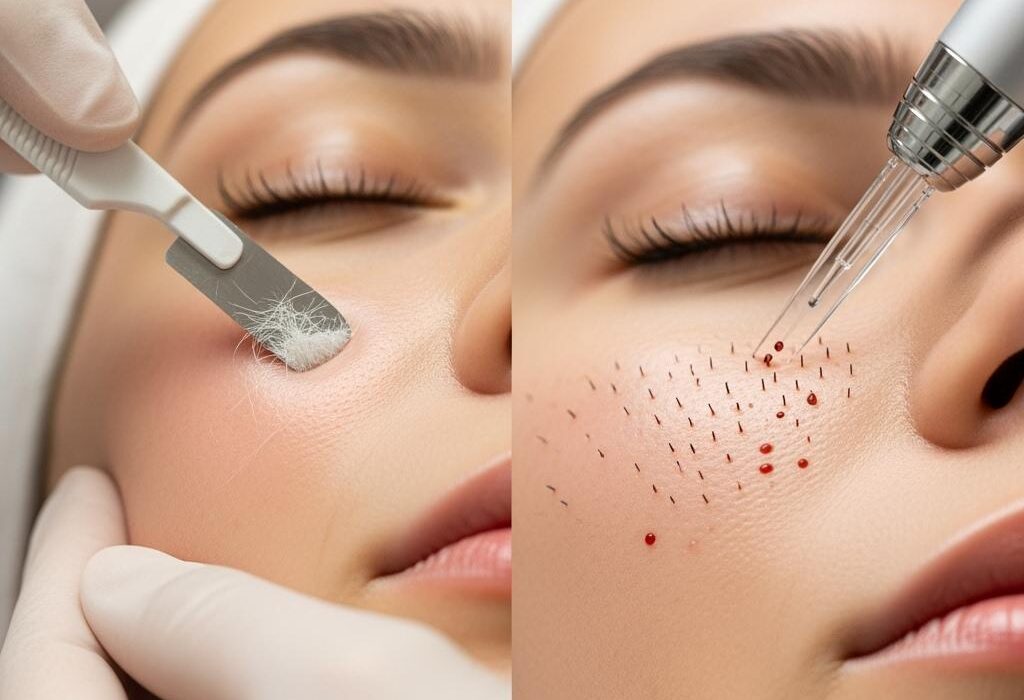When it comes to achieving smoother, brighter, and healthier-looking skin, two of the most popular non-invasive treatments are dermaplaning and microneedling. Both treatments improve skin texture and appearance, but they work in very different ways. Understanding their differences, benefits, and ideal uses can help you decide which is best for your skincare needs.
What Is Dermaplaning?
Dermaplaning is a cosmetic treatment that uses a sterile surgical scalpel to gently exfoliate the skin’s surface. By removing dead skin cells and fine vellus hair (commonly known as peach fuzz), dermaplaning leaves the skin instantly smoother and brighter. The treatment is painless, requires no downtime, and gives makeup a flawless finish.
Key Benefits of Dermaplaning:
-
Removes dead skin cells and peach fuzz
-
Improves product absorption
-
Creates a smooth surface for makeup
-
Provides instant results with no recovery time
Dermaplaning is particularly effective for those with dull skin, dry patches, or uneven texture. However, it does not treat deeper skin concerns such as acne scars, pigmentation, or fine lines.
What Is Microneedling?
Microneedling, also called collagen induction therapy, involves using a device with fine needles to create controlled micro-injuries in the skin. These micro-channels stimulate the body’s natural healing process, leading to increased collagen and elastin production. Over time, this helps reduce scars, wrinkles, enlarged pores, and uneven skin tone.
Key Benefits of Microneedling:
-
Boosts collagen and elastin production
-
Improves acne scars, fine lines, and wrinkles
-
Reduces hyperpigmentation and sun damage
-
Enhances skin firmness and elasticity
Unlike dermaplaning, microneedling addresses deeper skin issues, making it ideal for those seeking long-term rejuvenation. However, it may involve mild redness and requires short recovery time, usually 24–72 hours.
Comparing Dermaplaning vs Microneedling
Although both treatments enhance skin appearance, their approaches and results differ significantly.
Depth of Treatment:
-
Dermaplaning works on the surface of the skin by exfoliating dead cells and hair.
-
Microneedling penetrates deeper, triggering skin repair and collagen renewal.
Results:
-
Dermaplaning gives instant smoothness and glow, but results are temporary (lasting a few weeks).
-
Microneedling results develop gradually as collagen builds up, but they are longer-lasting.
Best For:
-
Dermaplaning: Quick skin refresh, peach fuzz removal, and smoother makeup application.
-
Microneedling: Reducing scars, wrinkles, pigmentation, and improving overall skin texture.
Downtime:
-
Dermaplaning: No downtime.
-
Microneedling: Mild redness and sensitivity for 1–3 days.
Which Treatment Should You Choose?
The choice between dermaplaning and microneedling depends on your skin concerns and goals:
-
If you want instant glow, smoother skin, and better makeup application, dermaplaning is the best choice.
-
If you want to treat scars, fine lines, and pigmentation for long-term improvement, microneedling is more effective.
Some individuals even combine both treatments over time—using dermaplaning for surface exfoliation and microneedling for deeper rejuvenation. Consulting with a licensed skincare professional is the best way to determine the right approach for your skin type and concerns.
Final Thoughts
Dermaplaning and microneedling are both effective treatments, but they serve different purposes. Dermaplaning focuses on surface-level exfoliation and immediate radiance, while microneedling works deeper to repair and renew the skin from within. Whether you’re preparing for a special event or looking for long-term rejuvenation, choosing the right treatment can help you achieve healthier, more radiant skin.





